Style
Lover’s Eye Jewels Enjoyed a Vogue 300 Years Ago. Now They’re Experiencing a Surprise Resurgence
We dig into the long history of a trend that's suddenly getting major attention.
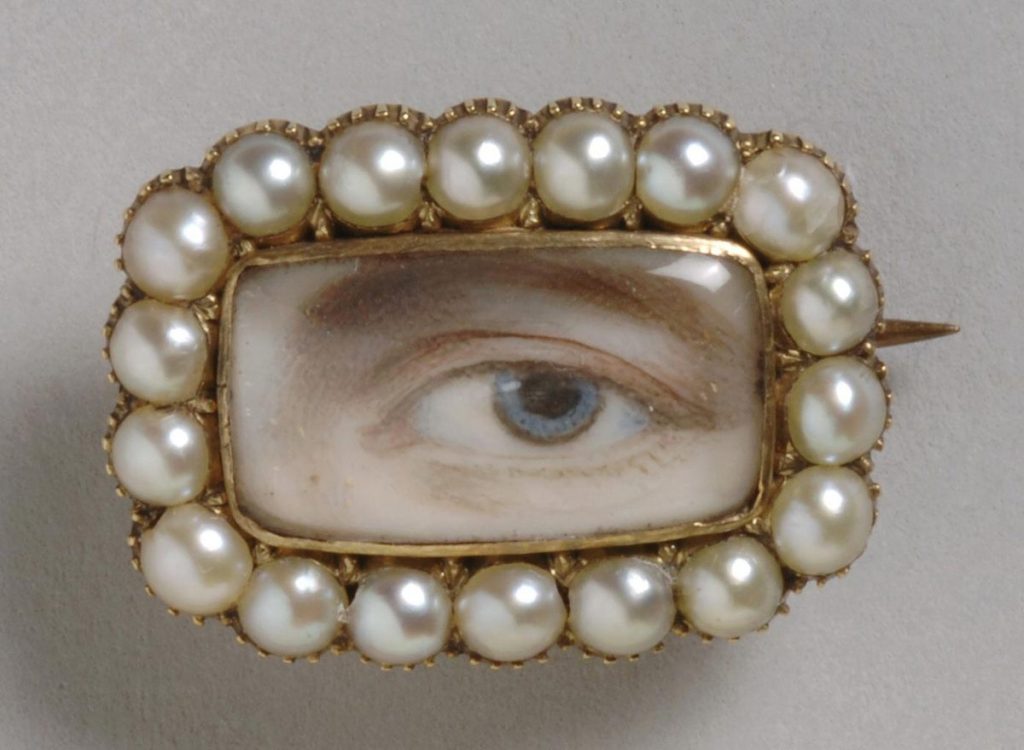
We dig into the long history of a trend that's suddenly getting major attention.

Katie White

The story begins with star-crossed 18th-century lovers: Prince George of Wales, a Protestant royal and heir to the English throne (and later King George IV), found himself enchanted with Maria Anne Fitzherbert, a twice-widowed devout Catholic, six years his senior.
“Nothing good comes easy” might have been George’s motto as the Prince had set himself on wedding Fitzherbert, even though marital unions between Catholics and Protestants were strictly forbidden in 18th-century England. Fitzherbert seemed keen to avoid controversy herself, and had initially refused the royal’s advances, going so far as to travel abroad to avoid his entreaties.
But Prince George, undeterred, had an unexpected romantic token in mind to woo her.
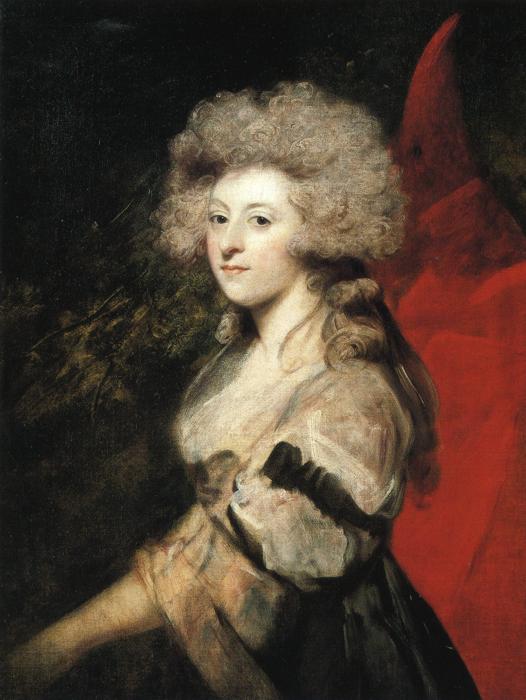
Sir Joshua Reynolds, Maria Anne Fitzherbert (1788). Collection of the National Portrait Gallery.
In 1785, Fitzherbert opened a letter from her suitor only to find a peculiar jewel: a small painting of the Prince’s right eye floating against an empty background and surrounded by jewels.
Though we have no written records of Fitzherbert’s response, the gesture seems to have made an impression, as the couple clandestinely wed later that year. Fitzherbert is known to have reciprocated, too, sending George a painting of her own eye that he would wear under this lapel for many years.
Though the secret marriage went unrecognized (it had not been given approval by the King), the couple’s illicit exchange of jewels prompted a fervor for these mysterious miniature portraits that would last several decades. Now known as Lover’s Eyes, the jewels typically featured a watercolor portrait on ivory of a single eye belonging to a beloved, be it a spouse, a mistress, a dear relative, or a child. The jewels were often set a pins or rings even bracelets.
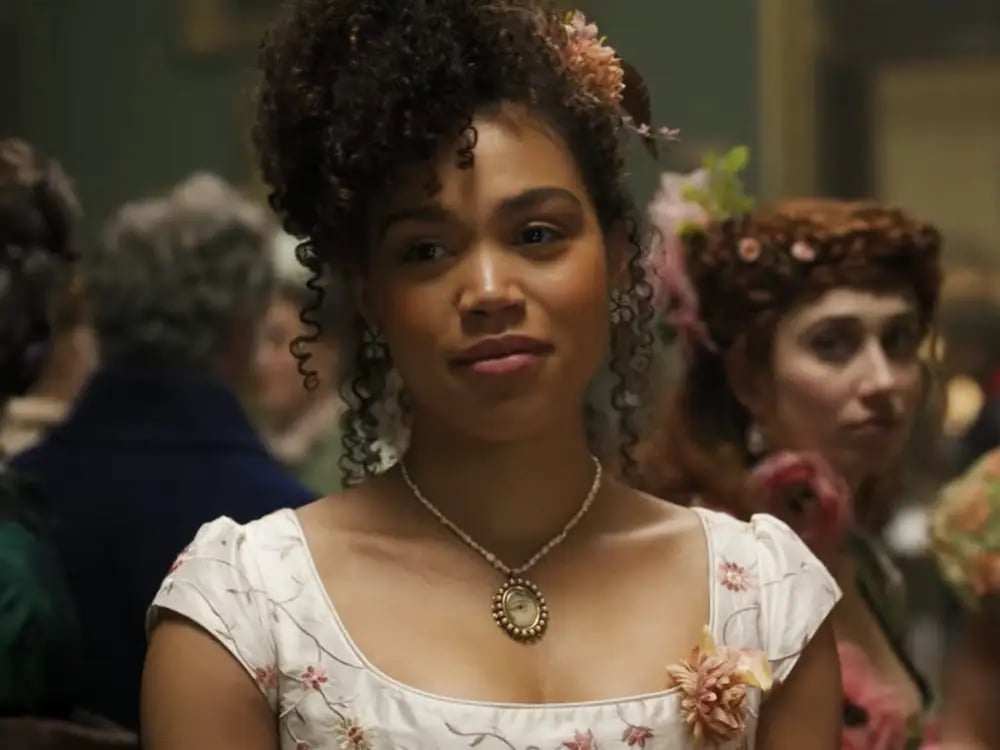
Marina Thompson wearing a Lover’s Eye in Season 1 of Bridgerton. Courtesy of Netflix.
Now, these fascinating jewels are experiencing a popular resurgence. In season one of Bridgerton, the character Marina Thompson repeatedly appears wearing a Lover’s Eye jewel as a choker; here the jewel serves as a costuming clue into her conflicted romantic arc.
In the fall of 2021, jewelry expert Elle Shushan published the marvelous book Lover’s Eyes: Eye Miniatures from the Skier Collection. The book explores these jewels absorbing history through the collection of David and Nan Skier, Alabama-based collectors who own the most significant trove of Lover’s Eyes in the world. Contemporary jewelers, too, have even taken to making their own reinterpretations of the jewels with modern innovations.
Curious about this vogue, we set out to explore the history of this obscure jewel and find out what is driving its renewed popularity.
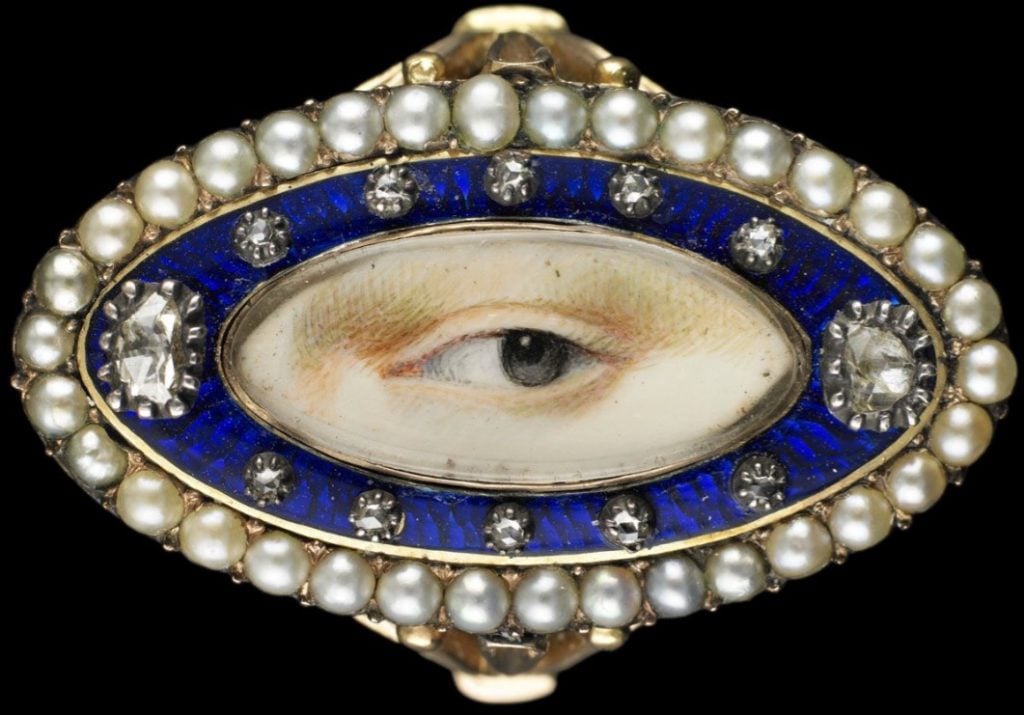
Blue enamel, diamond, and pearl broch (c.a. 1790). Courtesy of the Skier Collection.
Though the Prince of Wales and his beloved Maria sparked a popular trend, the couple were not the first to create the jewels. The Lover’s Eye first appeared in Britain in the 1780s (the genre was a largely English phenomenon, though there are a smattering of particularly early examples originating in France). As with the case of these royal paramours, many of the jewels were exchanged by lovers, but were also at times intended as mementos of adored family members, or even in certain cases, mourning emblems honoring someone who had died.
Lover’s Eye is, in fact, an anachronistic descriptive designation; in their own time, these jewels were known simply as eye miniatures. “The term ‘Lover’s Eye’ was coined by Madison Avenue antique dealer Edith Weber in the 20th century. She sold many of these jewels and she made up the phrase and a whole story around them to attract buyers and freely admitted to having done so,” Shushan told Artnet News.
The diminutive ocular portraits did, however, have historical roots in the long tradition of European miniature painting. Portrait miniatures originated as early as the 16th century in France with the famed Jean Clouet (a so-called father of the genre) and were later perfected by Jean Petitot, the first artist truly famous for miniatures. Flemish painter Lucas Horenbout, who painted under King Henry VIII, first introduced the style to England in the 16th century. Miniatures flourished further in England under Hans Holbein and subsequent generations of his tutelage. These petite, delicately wrought portraits were typically made on materials including vellum, copper, and ivory—materials that defined the earliest Lover’s Eye portraits.
“By the 1790s miniatures were already hundreds of years old and getting a bit boring,” Shushan said. “People were looking for something new and exciting and that’s what Lover’s Eyes provided.”
Unlike the tradition of miniatures, however, these jeweled eyes were mostly by anonymous artists. A few celebrities of the Lover’s Eye genre have been identified today. For instance, the painter George Engleheart, a superstar artist of 18th-century London who was known for keeping meticulous books. In his career, Engleheart is known to have painted some 23 eyes. Artist Richard Cosway is another of the small circle of known artists of the genre and served as a miniature painter to the Prince of Wales starting in 1786. Other artists we know of include William Wood and William Grimaldi who were both well-established talents in 18th-century England.
For collectors, discovering works by known artists is a rare thrill—though somewhat beside the point. Prominent collectors David and Nan Skier first encountered Lover’s Eyes in the 1980s while in Boston for a medical convention. (David is befittingly an ophthalmologist.) The couple visited a nearby antique show with a booth by the one-and-only Edith Weber with Barry Weber, her son, manning the booth.
In a conversation, Nan Skier recalled this long-ago experience with palpable enchantment. “In the case was this beautiful ring of blue enamel with diamonds and in the center was a hand-painted watercolor of an eye on ivory. We’d never seen anything like it. We were absolutely astonished and thought it was incredibly beautiful,” Skier said.
Today, the Skiers have the largest collection of Lover’s Eyes in the world, with over 100 jewels to their names. The couples’ collection went on view at the Birmingham Museum of Art in 2012 with the exhibition “The Look of Love.” Within this sprawling collection, they have identified just a handful of works by Engleheart and Cosway. “We have one that is signed with an ‘E,’ so we know that that is by Englehart. But they’re so tiny that there’s really no way to sign them and that’s the only one that has any sort of an identifier as far as the artist. We have some that we know are by Richard Cosway because of provenance or by style,” Skier said.
She emphasizes that while identifiable artists certainly add some cache to the works, all extant and authentic Lover’s Eyes are precious in today’s market—only approximately a thousand genuine examples exist and the once-worn jewels are objects of great fragility.
“The first ring we purchase came with a story but it also came with a warning,” Skier recalled. “The warning was: ‘please do not wash your hands while you are wearing this ring.’ The image is watercolor on ivory, and even though the image is under glass, if water gets in there, the image will wash away even though it’s 200 years old.”
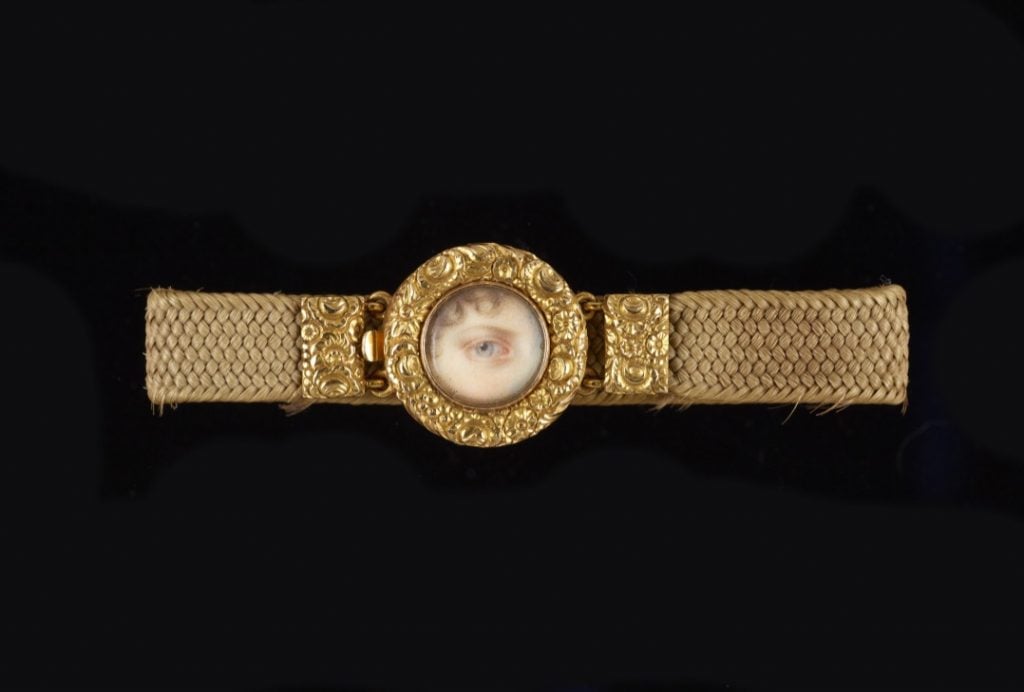
Princess Charlotte’s eye in a bracelet of her hair (1817). Collection of David and Nan Skier.
One of the prizes of the Skiers collection is a Lover’s Eye that links back to the romantic saga of Prince George and Maria Fitzherbert.
After the Prince’s union with Fitzherbert was declared illegitimate, George was pushed into marriage with Caroline of Brunswick. The marriage was notoriously volatile and unhappy from the start (after their first meeting, George purportedly demanded a brandy). But it did produce one heir, Princess Charlotte. Beloved throughout England, Charlotte’s life was cut short during childbirth while still in her 20s. Her death sent the nation into a period of mourning. “One of the pieces that we have is an eye miniature of Princess Charlotte, given at the time of her death. The jewel has a bracelet that is woven out of locks of her hair,” Skier explained.
In fact, it was not uncommon for Lover’s Eyes to have such symbolism physically encoded into the jewel itself. Jewelry and decorative arts historian Levi Higgs notes that details in the jewels often have symbolism. One of his favorite Lover’s Eyes is a gold bracelet featuring an eye set amid swirls of ivy, from the collection of the Metropolitan Museum of Art.
“There is symbology to ivy and the act of looking through the hedges. Ivy is so strong and resilient and grows everywhere, so I could imagine it being a symbol of everlasting love, in this case” Higgs said.
“The gemstones can be very symbolic, too,” he continued. “Pearls around the edges can be references to mourning or tears. Coral is considered a protective stone. If you had a miniature of your child’s eye or your husband’s eye and he was off at war, you’d want coral around that eye to protect them.” Many other stone settings are simply aesthetic, however. “Garnets or diamonds just became a more fashionable choice,” Higgs says of later Lover’s Eyes.
While eye miniatures were certainly the dominant trend in the 18th and early 19th century, on rare occasions another feature was isolated. Higgs points to the Met’s Beauty Revealed, which isn’t an eye miniature at all but rather a closed-cropped portrait of a woman’s breast.
“The artist, Sarah Goodridge, painted this portrait miniature of her breast to give to her lover, Daniel Webster. They’re beautifully rendered and it’s just so cheeky. Goodridge painted this in 1828—which would have been a very scandalous gift to give,” he added.
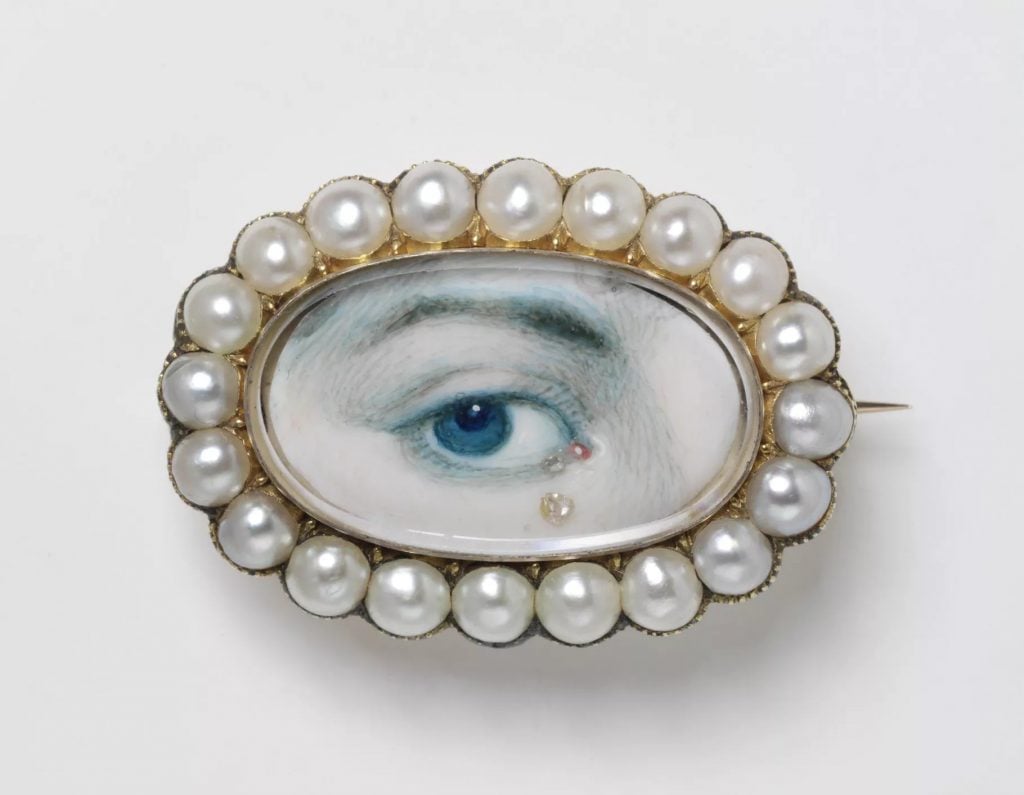
Eye Miniature, early 19th century. Collection of the Victoria and Albert Museum, London.
“As Barry Weber told us: as prices rise, fakes follow,” Skier remarked when asked about the prevalence of fraudulent Lover’s Eyes on the market. How might a Lover’s Eye be faked? Countless are the ways, it seems.
“If you look at Lover’s Eye carefully with a jeweler’s loop, you’re looking for brush strokes of watercolor on ivory which would have been painted with a very tiny brush. It has been known that people actually take a color copy and put those into an antique housing and sell them as authentic,” Skier noted. “Other times, people will take a portrait miniature for the period and will cut out the eye part and put it into an antique jewel casing. I would say that 90 percent of the ones that we have been shown are not correct in some way.”
But not all Lover’s Eyes from later decades are fakes. Some are contemporaneous fashion trends. In the first decade of the 20th century, these jewels became popular again and were worn by the demimonde of London society, including Queen Alexandra, her rival the Countess of Warwick, and perhaps most famously, the Duchess of Marlborough who owned a double locket set with her left and right eyes.
The trend toward Lover’s Eyes as fashion objects, rather than commissioned portraits started as early as the 1810s. “Eye miniatures had gained enough acclaim to trigger the leap into the popularity of jewelry set with generic eyes,” Shushan wrote in her essay, “Fake or Fashion.” “It is probable that… journeymen artists began painting eyes for jewelers. Set in gold with pearls or semi-precious stones, these eyes made magnificent ornaments without the time or expense of sitting for an artist,” she added.
While the eyes created by top-tier artists of the late 18th century were almost photorealistic in quality, detailed often by only a curl of hair or brow, over time, these paintings became larger, and often less specified in quality by the 1840s and ‘50s. Later eye miniatures made as fashion objects often have their own defining characteristics—for instance, the inclusion of diamond tears indicates a 20th-century jewel.
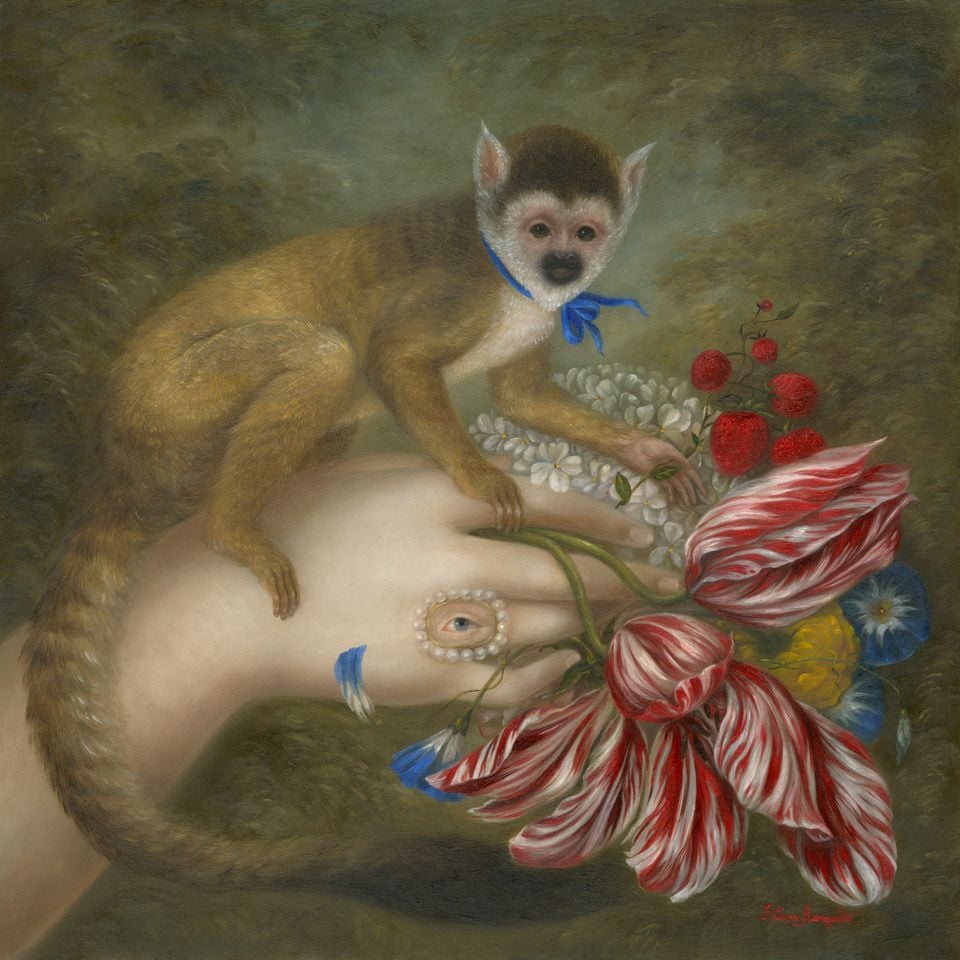
Fatima Ronquillo, Hand with Squirrel Monkey, and Lover’s Eye (2020). Courtesy of the artist and Meyer Galleries.
Jewelers—and collectors—seem to be smitten with Lover’s Eyes once more. But why now?
“Lover’s Eyes are so relevant today because of the experiences of quarantine over the past few years. We wanted to be close to one another and sentimental jewelry about the fondness you feel for someone you might not see for months and months felt very powerful. The eye is a secretive way to have closeness on your person,” Higgs suggested.
Now a handful of contemporary jewelry designers are directly referencing Lover’s Eyes in their own creations, but with contemporary updates. Artist Susannah Carson, for instance, creates contemporary eye miniatures which she sets in antique casings but also features the eyes on plates and housewares. Design duo and twin brothers David and Michael Robinson hand-make one-of-a-kind jewels that often take inspiration from classical techniques, including Lover’s Eyes.
The duo have put their own spin on these jewels, however, working primarily with mother of pearl as the base for their works, rather than ivory and vellum, and creating much more ornate jewels casing than were typical. They’ve also moved into the territory of man’s best friend.
“I also often do pets portrait. We all love our pets more than ever today, so I thought it would be fun to do cute and playful pet’s Lover’s Eyes,” said Michael Robinson.
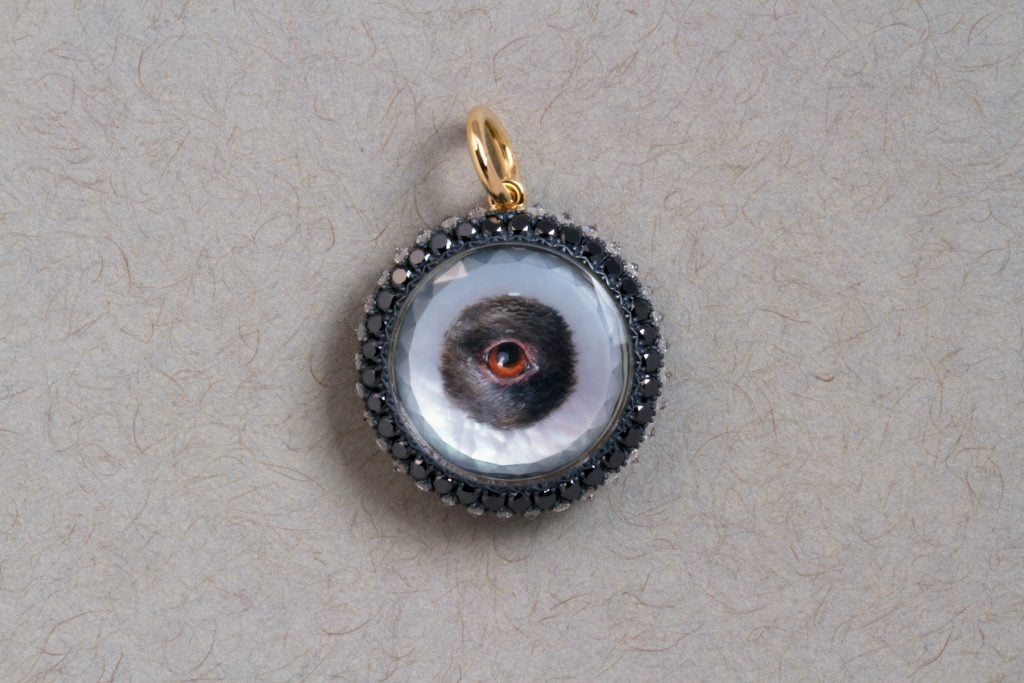
A pet portrait Lover’s Eye by David Michael Jewels. Courtesy of David Michael Jewels.
Meanwhile, Fatima Ronquillo, a Santa Fe-based contemporary artist, has made Lover’s Eye jewels a central feature of her often otherworldly canvases.
Ronquillo finds beauty in the surreal aspect of an isolated eye. “The idea of physical dismemberment which is symbolic of removal or estrangement of a loved one reminds me of the Mexican milagros—little charms of different body parts used to aid in praying for the healing of broken arms or hearts, or even eyes,” Ronquillo said. “For me, it’s an iconic symbol about the figure represented not unlike the reliquaries of saints in old devotional images. Love tokens such as Cupid’s arrow, the billet-doux, or the Lover’s Eye are symbolic of the figure represented and the absent figure―the object or source of affection or heartbreak.”
For the Skiers, it is the power of that love and longing that makes these objects so immediately captivating even centuries later.
“Each one of these represents a love story of some sort. Each one of these people–known or unknown—had someone who loved them enough to commission a portrait of their eye and set it into a jewel,” Nan Skier said. “That’s the loveliest and most wonderful thing about collecting these—these are people who were loved.”